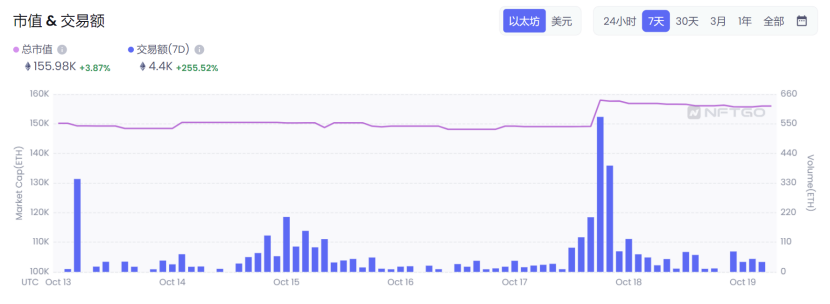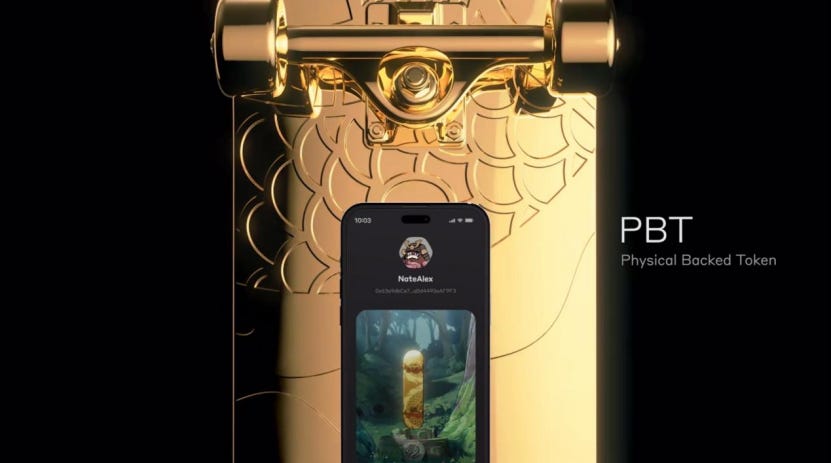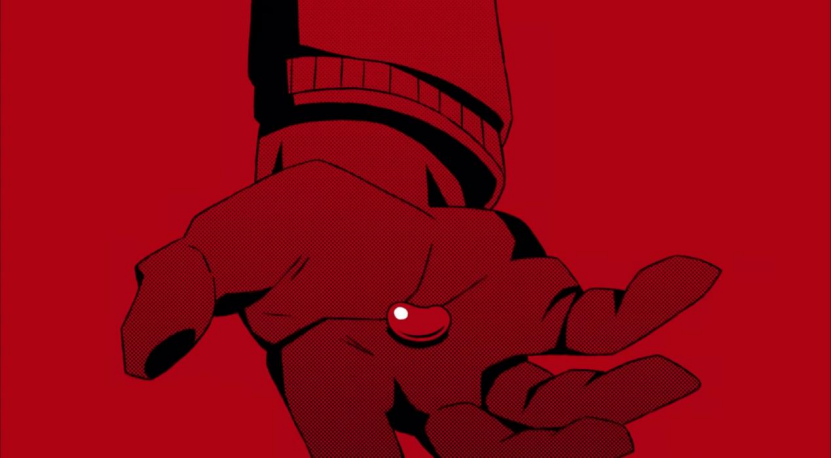Azuki PBT: Will real-world interaction with Web3 be the next narrative wave?
Author: Carol @CC99Carol Editor: Colin Wu Abstract: On October 18, 2022, Azuki released a new open source Token standard, Physical Backed Token (PBT). The highlight of the standard is that it supports binding real items to the ethereum blockchain for decentralized authentication and tracking the ownership along of physical items, and the whole process is fully deployed on the chain without any centralized server intervention. Based on this standard, a model called Scan to Own was born, which is dedicated to decentralized transfer of ownership of physical objects through the combination with hardware, bringing a new experience to users. But as far as the actual situation is concerned, both PBT and Scan to Own are still unmature, and there is still a lot of resistance at the technical application level, but the concepts they contain undoubtedly coincide with Web3, and then think of Solana's release. Mobile, real-world interactions with Web3 world assets may be the next narrative wave. Foreword The launch of the Aptos mainnet has been the top hit recently, whether its value-added airdrop or the controversies and questions that have taken away most of the market's attention. But in fact, in addition to the dazzling new star of Aptos, some old projects have also begun to take action, such as well known NFT--Azuki. The volume of the long-simmering blue chip NFT Azuki has seen a sudden rise in recent days, reaching a three-month high of 879.76 ETH on October 17, and according to my speculation, the immediate trigger for this rise is probably related to the new features it has launched. On October 18, 2022, Azuki released a new open source Token standard, Physical Backed Token (PBT). The highlight of the standard is that it supports binding real items to the ethereum blockchain for decentralized authentication and tracking of ownership along physical items, and the whole process is fully deployed on the chain without any centralized server intervention. Based on this standard, a model called Scan to Own has emerged, which is dedicated to decentralizing the transfer of ownership of physical items by combining with hardware, bringing a new experience to users. So let's take a look at this new and futuristic feature of Azuki today. Great success after retreat? Many eople have been already familiar with Azuki, which is a collection of 10,000 anime NFTs. As a blue-chip NFT with oriental colors, Azuki's biggest characteristic is its beautiful drawing style and Japanese manga style mixed with American street culture. Due to its outstanding drawing style, Azuki gained a large number of fans right after its launch, and with the active operation of its team, Azuki's influence has been expanding. Today, it has firmly ranked among the blue-chip NFTs and has become one of the most representative phenomenal projects in the NFT market. But as one of the biggest beneficiaries of NFT Summer, Azuki is also inevitably affected by the overall market sentiment. As a result, with the onset of the bear market at the beginning of the year, a number of blue chip NFTs, including Azuki, also suffered a huge impact. In addition, the PR crisis a few months ago also caused Azuki to fall further into silence, and it was even thought that Azuki would be kicked out of the blue-chip NFT category. After a few months of silence, Azuki is back with a new feature that is largely not just a gimmick to attract traffic, but a real attempt to solve the current problem of connecting Web3 and real-world asset ownership, while bringing a new narrative to crypto assets. To fully understand this feature, we first need to understand a new standard proposed by Azuki - PBT, which is at the heart of the matter. PBT - Knocking on the door of reality PBT, known as Physical Backed Token, is a new token standard proposed by Azuki. The highlight of this standard is that it can bind real goods to the ethereum blockchain through the combination with physical chips, in order to achieve decentralized authentication and ownership of physical goods, and the whole process above is completely deployed on chain, without any centralized server intervention. In fact, connecting real goods with cryptocurrencies is not a novel narrative anymore, and many Web3 vendors have applied similar concepts. But in previous similar projects, the connection between real commodities and cryptocurrencies often came to an abrupt end after the minting was completed, to the point of anticlimactic. PBT is different from this. Its biggest feature is that it establishes a complete virtual-reality ownership chain, and users can synchronize the upstream and downstream chain of asset ownership by casting decentralized assets, decentralized identification, and physical monitoring. But all this is obviously difficult to achieve only with on-chain data technology, so Azuki introduced a network chip that supports on-chain authentication - BEAN chip. 1. BEAN chip Created by Azuki in collaboration with Kong, the BEAN chip automatically generates asymmetric key pairs. By combining PBT with this chip, users can achieve a Scan to Own mode. In this mode, users can quickly decentralize the transfer of PBTs from the original owner to the new owner by scanning the items preloaded with the chip. Specifically, the combination of PBTs and BEAN chips can lead to the following use cases. -Decentralized authentication of goods: simply scan the physical item with your phone to authenticate it. -Tracking ownership of physical goods along the way: verifiably proving the past and present owner of the item, enabling brands to build product experiences for their audiences. -Create digital experiences with physical products: owning digital tokens unlocks physical drops, and now owning physical products unlocks digital experiences. It is easy to see that the combination of the two is essentially essentially to digitally upload real items to the chain through on-chain protocol standards and hardware scanning, so as to achieve double confirmation of on-chain and off-chain rights. And on October 21, the first tangible product supporting PBT, nine Golden Skateboards, was also officially launched. Each skateboard is designed with high-precision structure and all plated with 24k gold, weighing 20.5kg. 2、Project Construction Currently, Azuki is working on an EIP submission for PBT. The PBT's official website also provides documentation for reviewing EIP submissions, technical documentation, and open source GitHub repositories.It hopes to allow developers to build projects using PBT in the future, thus telling the story of knocking on the door of the real world. Web3 needs not only cross-chain bridges, but also cross-border bridges Web3 is a topic that is often mentioned, especially in the crypto world, where it seems to be the most mainstream talking point. But in reality, many people may not have a very clear understanding of Web3. What does this so-called third generation of the Internet have to offer over the previous one? Is it faster Internet speed? More performance? Or is there some kind of endless technological innovation? In fact, the core of the Web3 discussion does not fall into these categories. In my opinion, the three generations of the Internet so far have essentially emphasized the issue of rights, i.e., putting the rights back in the hands of the real owners. In the Web1 Internet environment, users usually could only passively read the content released by the platform; while in the Web2 stage, users can be more active as the subject of content release; now, with the advent of the Web3 era, we as users are trying to regain the dominant power of the attention economy, in other words, the users themselves decide what to watch, and the economic value generated in this process will also be determined by the users. The economic value generated in this process will also be controlled by the users. In this context, Web3 has emerged to further define property rights from the source. To this end, a number of facilities have emerged under the name of decentralization: DeFi (decentralized finance), DEX (decentralized exchange), DAO (decentralized autonomous organization) ...... While it is true that the emergence of these facilities has partly improved the problem of decentralization, it is also important to realize that the current Web3 may have placed too much emphasis on the establishment of a separate entity, so that its development is still strongly separated from the real world. We can see this in the names of some facilities. DeFi, for example, seems to exist as the rightful antithesis of centralized finance, and DAO, the decentralized autonomous organization, also seems to be at odds with centralized institutions. It is true that Web3 should negate something, but we should also realize that negation is not to negate, but to solve. And the problem of rights is meaningless if it cannot be solved in real life. Therefore, the path of Web3 should probably not be a separate one, but rather an integration with the real world. A long way to go The PBT we are presenting today is actually an attempt to connect Web3 to the real world. It adopts the idea of synchronizing the upstream and downstream chains by means of on-chain protocols and physical chips. This makes the on-chain of real commodities a continuous and observable state, which stably realizes the construction of a bridge between Web3 and reality. Compared with the previous attempts, PBT is undoubtedly more concerned with the process itself. However, at this stage, it is still difficult to popularize this approach. First of all, the high cost and production complexity brought by the physical chip model may cause difficulties in popularization. Second, the EIP proposal for the PBT protocol is currently under review, and whether it can be passed is still unknown. Even if it can be passed, the problem of chips may become an obstacle to the promotion of the protocol. Therefore, there is undoubtedly still a long way to go to connect Web3 with reality. But even so, we have to admit that Azuki did make some interesting attempts. This may also provide ideas for future cross-border solutions. We'll have to wait and see if Azuki can tell this story well. Follow us Twitter: https://twitter.com/WuBlockchain Telegram: https://t.me/wublockchainenglish If you liked this post from Wu Blockchain, why not share it? |
Older messages
Opinion: Industrial assembly line of Aptos public chain, the quality of ecological projects is worrying
Tuesday, October 25, 2022
On October 18, Aptos, which completed a $150 million round of funding led by FTX Ventures and Jump Crypto in July, valued at $2.75 billion, announced the launch of its mainnet, Aptos Autumn, and
Global Crypto Mining News (Oct 17 to Oct 23)
Monday, October 24, 2022
1. Bitcoin miner Digihost received notice of possible delisting from Nasdaq for trading below $1. The company has 180 days to fix the issue or otherwise risks seeing its stock removed from trading at
Review of the whole process:3Commas API KEY ‘leak’, FTX user funds was stolen by contra trade
Monday, October 24, 2022
On October 21, a Chinese user broke the news to WuBlockchain: his FTX account suddenly went "crazy" on the night of the 19th with more than 5000 transactions, and his account assets of $1.6
Asia's weekly TOP10 crypto news (Oct 17 to Oct 23)
Sunday, October 23, 2022
Author:Lily Editor:Colin Wu 1. Huobi's weekly summary 1.1 Justin Sun plans to make Huobi Global the top three in the world link Justin Sun tweeted that he will concretely land measures to empower
Weekly project update: frxETH was introduced, Polkadot CEO resigns, Bitget cooperated with Messi and Top 10 projec…
Saturday, October 22, 2022
1. Publicchain Sui's weekley summary a. Sui: There are currently no official airdrop plans. link Public Chain Sui announced on October 22 that SUI Token is not currently available online or for
You Might Also Like
What is DeFAI? The AI-enabled DeFi narrative looking to take 2025 by storm
Wednesday, January 15, 2025
AI-driven DeFi projects aim to simplify finance with real-time insights, trading, and personalized strategies, but face hurdles in transparency and security. ͏ ͏ ͏ ͏ ͏ ͏ ͏ ͏ ͏ ͏ ͏ ͏ ͏ ͏ ͏ ͏ ͏ ͏ ͏ ͏ ͏ ͏
DeFi & L1L2 Weekly — 📈Solana’s daily DEX trading volume beat Ethereum’s by 84%; Sony launched its L2 blockchain, …
Wednesday, January 15, 2025
Solana's daily DEX trading volume beat Ethereum's by 84%. Sony launched its L2 blockchain, Soneium. Compound integrated Ethena's stablecoin and Mantle's liquid staking token. ͏ ͏ ͏ ͏ ͏
DeFi & L1L2 Weekly — 📈Solana’s daily DEX trading volume beat Ethereum’s by 84%; Sony launched its L2 blockchain, …
Wednesday, January 15, 2025
Solana's daily DEX trading volume beat Ethereum's by 84%. Sony launched its L2 blockchain, Soneium. Compound integrated Ethena's stablecoin and Mantle's liquid staking token. ͏ ͏ ͏ ͏ ͏
OKX Founder's Full Speech: "Always Hold Bitcoin"
Wednesday, January 15, 2025
January 14, 2025, OKX CEO Star delivered a speech via video link. ͏ ͏ ͏ ͏ ͏ ͏ ͏ ͏ ͏ ͏ ͏ ͏ ͏ ͏ ͏ ͏ ͏ ͏ ͏ ͏ ͏ ͏ ͏ ͏ ͏ ͏ ͏ ͏ ͏ ͏ ͏ ͏ ͏ ͏ ͏ ͏ ͏ ͏ ͏ ͏ ͏ ͏ ͏ ͏ ͏ ͏ ͏ ͏ ͏ ͏ ͏ ͏ ͏ ͏ ͏ ͏ ͏ ͏ ͏ ͏ ͏ ͏ ͏ ͏ ͏ ͏ ͏ ͏
JPMorgan believes Solana, XRP ETPs could attract $15 billion in net inflows
Tuesday, January 14, 2025
Both assets register $2.5 billion in assets under management currently, with a little over $500 million in inflows registered last year. ͏ ͏ ͏ ͏ ͏ ͏ ͏ ͏ ͏ ͏ ͏ ͏ ͏ ͏ ͏ ͏ ͏ ͏ ͏ ͏ ͏ ͏ ͏ ͏ ͏ ͏ ͏ ͏ ͏ ͏ ͏ ͏
Coin Metrics’ 2025 Crypto Outlook
Tuesday, January 14, 2025
Key Trends & Outlooks Shaping Digital Assets in the Year Ahead ͏ ͏ ͏ ͏ ͏ ͏ ͏ ͏ ͏ ͏ ͏ ͏ ͏ ͏ ͏ ͏ ͏ ͏ ͏ ͏ ͏ ͏ ͏ ͏ ͏ ͏ ͏ ͏ ͏ ͏ ͏ ͏ ͏ ͏ ͏ ͏ ͏ ͏ ͏ ͏ ͏ ͏ ͏ ͏ ͏ ͏ ͏ ͏ ͏ ͏ ͏ ͏ ͏ ͏ ͏ ͏ ͏ ͏ ͏ ͏ ͏ ͏ ͏ ͏ ͏ ͏ ͏
Bitcoin’s sharp rise and fall starts week with $418 million in liquidations
Monday, January 13, 2025
Crypto positions unwind with $245M in longs liquidated across major exchanges. ͏ ͏ ͏ ͏ ͏ ͏ ͏ ͏ ͏ ͏ ͏ ͏ ͏ ͏ ͏ ͏ ͏ ͏ ͏ ͏ ͏ ͏ ͏ ͏ ͏ ͏ ͏ ͏ ͏ ͏ ͏ ͏ ͏ ͏ ͏ ͏ ͏ ͏ ͏ ͏ ͏ ͏ ͏ ͏ ͏ ͏ ͏ ͏ ͏ ͏ ͏ ͏ ͏ ͏ ͏ ͏ ͏ ͏ ͏ ͏ ͏
₿ US-based entities hold 65% more BTC reserves than non-US entities; Crypto.com launched stocks and ETFs trading i…
Monday, January 13, 2025
US-based entities hold 65% more BTC than non-US entities; Crypto.com launched stocks and ETFs trading in the US; South Korea is reportedly planning to gradually allow institutional crypto trading ͏ ͏ ͏
Crypto Crash Imminent As US DOJ Sells Over 69K BTC
Monday, January 13, 2025
Monday Jan 13, 2025 Sign Up Your Weekly Update On All Things Crypto TL;DR Crypto Crash Imminent As US DOJ Sells Over 69K BTC Senator Lummis To Head New Crypto Subcommittee Dogecoin Fails To Break
2024 Cex Annual Report: Binance's lead narrowed, while Bybit spot and Bitget contracts grew significantly
Monday, January 13, 2025
In December, major exchanges recorded a 14% increase in spot trading volume, with Bitget leading at 102% growth, and a 6% rise in derivatives trading volume, where Gate saw the largest increase at 111%





